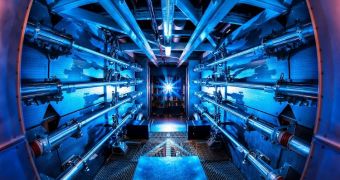Officials with the US National Ignition Facility (NIF) announce that their installation recently produced the highest-power laser shot ever, as part of efforts to achieve nuclear fusion. The NIF was developed specifically for igniting a self-sustaining fusion reaction between hydrogen isotopes.
During the recent test, the 192-laser installation created a light pulse of 500 trillion watts (terawatts, TW). This is equivalent to 1,000 times the amount of energy the United States uses at any moment.
According to experts, the laser shot produced 1.85 megajoules of energy, which is around 100 times more than what any other laser can support. The historic event occurred on July 5, physicists say.
The mission the NIF faces is as simple as it is complex – recreate the conditions inside the Sun, where hydrogen isotopes fuse together to produce helium and vast amounts of energy. Ultimately, fusion power will be used to power up Earth's grids, like fission energy is used today.
However, achieving this objective is no walk in the park. Scientists need a laser that can heat a sample of hydrogen isotopes to millions of degrees, while applying huge pressure on the entire mixture.
On the bright side of things, if nuclear fusion starts, it will then be able to sustain itself, but the requirements for this to happen are tremendous. The 192 lasers that make up NIF were built specifically to reach the energy levels required to jump-start fusion, Space reports.
“The 500 TW shot is an extraordinary accomplishment by the NIF Team, creating unprecedented conditions in the laboratory that hitherto only existed deep in stellar interiors,” Massachusetts Institute of Technology (MIT) physicist, Richard Petrasso, explains.
The laser facility is located at the US Department of Energy's (DOE) Lawrence Livermore National Laboratory (LLNL). Physicists say that all light sources fired for only a few trillionths of a second each, while the new tests were carried out.
Their light was focused on a small test chamber, which contained a capsule filled with the two most common hydrogen isotopes, deuterium and tritium. “NIF is becoming everything scientists planned when it was conceived over two decades ago,” says director Edward Moses.
“It is fully operational, and scientists are taking important steps toward achieving ignition and providing experimental access to user communities for national security, basic science and the quest for clean fusion energy,” he concludes.

 14 DAY TRIAL //
14 DAY TRIAL //